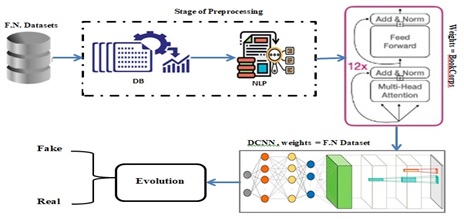Enhancing the Fake News Classification Model Using Find-Tuning Approach

DOI:
https://doi.org/10.54060/jieee.v4i1.92Keywords:
Fake News, BERT model, Transfer Learning, Text Classification, NLPAbstract
Over the last few years, the rise of fake news on social media has emerged as a significant issue, posing a potential threat to individuals, organizations, and society as a whole. As a solution to this issue, researchers have been using various natural language processing (NLP) techniques to detect fake news. In this study, we introduce a new strategy for fake news detection and classification. Our approach involves enhancing the performance of accuracy through fine-tuning, by merging BEART model with the proposed model DCNN. We have collected the data from secondary sources and combined it into a unified dataset. To improve its quality, we performed various processes such as data cleaning, transformation, integration, and reduction, which involved techniques like stop word removal, tokenization, and stemming, resulting in binary classification. Therefore, DCNN" was trained to classify news articles as real or fake, and the experiments on the dataset show that this approach performs better than several recent studies for detecting fake news, achieving high accuracy
Downloads
References
W. Li, J. Wu, X. Jia, and Y. Huang, “Fake news detection using deep learning: A survey,” Journal of Autonomous Intel-ligence, vol. 2, no. 1, pp. 24–33, 2019.
T. Young, D. Hazarika, S. Poria, and E. Cambria, “Recent trends in deep learning based natural language processing [review article],” IEEE Comput. Intell. Mag., vol. 13, no. 3, pp. 55–75, 2018.
Z. Wang, “Deep learning methods for fake news detection,” in 2022 IEEE 2nd International Conference on Data Sci-ence and Computer Application (ICDSCA), pp. 472-475, 2022.
N. Aslam, I. Ullah Khan, F. S. Alotaibi, L. A. Aldaej, and A. K. Aldubaikil, “Fake detect: A deep learning ensemble mod-el for fake news detection,” Complexity, vol. 2021, pp. 1–8, 2021.
Aggarwal, A., Chauhan, A., Kumar, D., Verma, S., & Mittal, M. (2020). “Classification of fake news by fine-tuning deep bidirectional Transformers based language model”. EAI Endorsed Transactions on Scalable Information Systems, vol. 7, no. 27, e10, 2020. https://eudl.eu/pdf/10.4108/eai.13-7-2018.163973
S. Garg and D. Kumar Sharma, “Linguistic features based framework for automatic fake news detection,” Comput. Ind. Eng., vol. 172, no. 108432, p. 108432, 2022.
R. K. Kaliyar, A. Goswami, and P. Narang, “‘FakeBERT: Fake news detection in social media with a BERT-based deep Learning Approach,” Multimedia Tools Appl, vol. 80, no. 8, pp. 11765–11788, 2021.
M. R. Khan, S. A. A. Shah, and A. Rehman, “Fake news dataset: a comprehensive analysis,” Human-centric Computing and Information Sciences, vol. 10, no. 1, pp. 1–23, 2020.
K. Shu, D. Mahudeswaran, S. Wang, D. Lee, and H. Liu, “FakeNewsNet: A data repository with news content, social context, and spatiotemporal information for studying fake news on social media,” ArXiv preprint arXiv: 1906.01370. 2019. https://doi.org/10.48550/arXiv.1809.01286
V. Pérez-Rosas, B. Kleinberg, A. Lefevre, and R. Mihalcea, “Automatic detection of fake news,” In Proceedings of the 27th International Conference on Computational Linguistics, pp. 3391-3401, 2017. https://aclanthology.org/C18-1287
J. Devlin, M. W. Chang, K. Lee, and K. Toutanova, “Bert: Pre-training of deep bidirectional transformers for lan-guage Understanding”. ArXiv preprint arXiv: 1810.04805. 2019. https://doi.org/10.48550/arXiv.1810.04805
W. Zhang, C. Liu, and Y. Wu, “Deep learning models for fake news detection: A review of recent progress and chal-lenges,” Expert Systems with Applications, vol. 172, 2021.
K. Shu, D. Mahudeswaran, S. Wang, D. Lee, and H. Liu, “FakeNewsNet: A data repository with news content, social context, and spatiotemporal information for studying fake news on social media,” Big Data, vol. 8, no. 3, pp. 171–188, 2020.
A. Thota, P. Tilak, S. Ahluwalia, and N. Lohia, “Fake news detection: a deep learning approach,” SMU Data Science Review, vol. 1, no. 3, 2018.
M. Farokhian, V. Rafe, and H. Veisi, “Fake news detection using parallel BERT deep neural networks,” arXiv [cs.CL], 2022.
J. Brownlee, “A gentle introduction to transfer learning for deep learning,” Machine Learning Mastery, 2017.
S. Kumar, R. Asthana, S. Upadhyay, N. Upreti, and M. Akbar, “Fake news detection using deep learning models: A novel approach,” Trans. Emerg. Telecommun. Technol., vol. 31, no. 2, e3767, 2020.
J. Xu, Y. Zhang, and D. Miao, “Three-way confusion matrix for classification: A measure driven view”. Information Sciences, vol. 507, pp. 772-794. 2020. https://www.sciencedirect.com/science/article/abs/pii/S0020025519306024
R. K. Kaliyar, ‘‘Fake news detection using a deep neural network,’’ in Proc. 4th Int. Conf. Comput. Commun. Autom. (ICCCA), pp. 1–7, 2018.
R. K. Kaliyar, A. Goswami, P. Narang, and S. Sinha, ‘‘FNDNet—A deep convolutional neural network for fake news Detection,’’ Available: http://www.sciencedirect.com/science/article/pii/S138904172030 085
O. Ajao, D. Bhowmik, and S. Zargari, “Fake news identification on twitter with hybrid CNN and RNN models,” in Proceedings of the 9th International Conference on Social Media and Society, New York, NY, USA, pp. 226-230, 2018.
A. S. K. Shu, D. M. K. Shu, L. G. M. Mittal, L. G. M. Mittal, and M. M. J. K. Sethi, ‘‘Fake news detection using a blend of neural Networks: An application of deep learning,’’ Social Netw. Comput. Sci., vol. 1, no. 3, pp. 1–9, Jan. 1970. [Online]. Available: https://link.springer. com/article/10.1007/s42979-020-00165-4.
P. Bahad, P. Saxena, and R. Kamal, ‘‘Fake news detection using bi-directional LSTM-recurrent neural network,’’ Proc. Available: http://www.sciencedirect.com/science/article/pii/S138904172030 085.
R. R. Mandical, N. Mamatha, N. Shivakumar, R. Monica, and A. N. Krishna, ‘‘Identification of fake news using ma-chine Learning,’’ in Proc. IEEE Int. Conf. Electron., Comput. Commun. Technol. (CONECCT), pp. 1-6, 2020.
R. K. Kaliyar, A. Goswami, and P. Narang, “‘FakeBERT: Fake news detection in social media with a BERT-based deep learning Approach,” Multimedia Tools Appl, vol. 80, no. 8, pp. 11765–11788, 2021.
M. Umer, Z. Imtiaz, S. Ullah, A. Mehmood, G. S. Choi, and B.-W. On, ‘‘fake news stance detection using deep learning Architecture (CNN LSTM),’’ IEEE Access, vol. 8, pp. 156695–156706, 2020. https://ieeexplore.ieee.org/document/9178321

Downloads
Published
How to Cite
CITATION COUNT
License
Copyright (c) 2023 Mohammed A. M. Ali, S. N. Lokhande, Safwan A. S. Alshaibani, Abdulrazzaq H. A. Al-Ahdal

This work is licensed under a Creative Commons Attribution 4.0 International License.

























